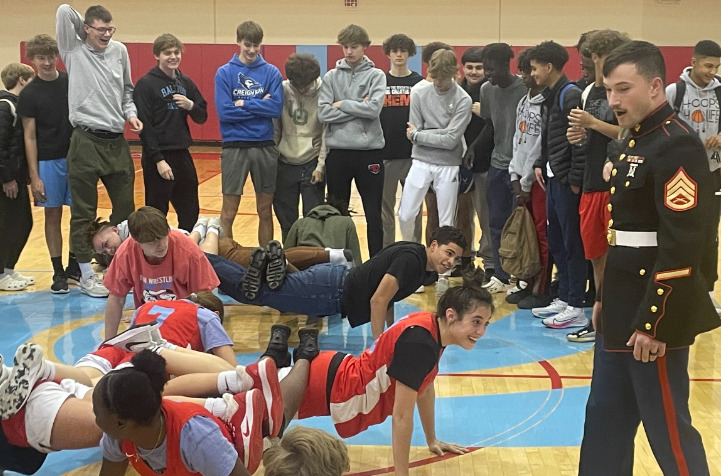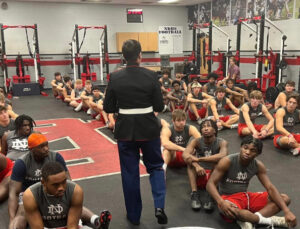
As some branches of the U.S. Armed Forces are coming up short in their recruitment efforts, officials are looking at creative ways to connect students with recruitment officers, as well as programs that increase the likelihood students are prepared to pass rigorous military entrance exams.
According to the U.S. Department of Defense (DoD), recruitment efforts for the U.S. Army, Navy and Air Force are not expected to meet their goals this year. During a hearing on recruitment efforts to the U.S. House Armed Services Committee in April, Gen. Randy A. George, the Army’s vice chief of staff, and Adm. Lisa M. Franchetti, the vice chief of naval operations, said those branches of service were doing better than expected, but will still fall short of their goals.
Both the Army and the Air Force are expected to fall 10,000 recruits short of their recruitment goals, while the Navy is expected to be about 6,000 enlistees short. The Marines and Space Force are expected to make their goals, they said.
Not only are eligible young Americans not applying, but many don’t qualify. Recent data from the Pentagon estimates that fewer than 25 percent of all Americans between ages 17 and 24 qualify either academically or physically, and that many of them can’t pass the Armed Services Vocational Aptitude Battery (ASVAB) testing that measures their aptitude and fitness.
“Fewer and fewer young Americans are eligible to even join the military due to health concerns, drug use, or mental health conditions,” said U.S. Rep. Jack Bergman (R-MI) a retired Marine lieutenant general and current member of the U.S. House Armed Services Committee. “Of the decreasing share of eligible Americans, fewer still have a desire to serve. Since the end of the Vietnam era, an increasing percentage of our all-recruited fighting force is coming from military families. This isn’t a bad thing, but we must find novel approaches to extol the virtues of serving our country to kids outside of traditional backgrounds,” Bergman told Homeland Preparedness News.
To help bolster the numbers, military leaders are turning to innovative efforts to engage young people across the country, and to prepare them for military life.
One effort led by DistrictWON, a Rocky River, Ohio-based company that specializes in creating marketing partnerships between parents, students and scholastic partners, reimagines recruitment efforts in high school settings. Instead of simply setting up tables in a lunchroom and waiting for students to engage with recruiters, the DistrictWON program engages students through leadership and teamwork sessions that allows recruiters to break through barriers and talk with students about their leadership potential within the military, and what options the military could hold in their life after graduation.
Last year, DistrictWON CEO Peter Fitzpatrick said, the company held hundreds of events across multiple states. This year, DistrictWON hopes to expand that.
“We will be tweaking the presentations a bit working with the different branches and probably catering to even larger audiences at the high schools,” he said. “We will also be incorporating technology more for some practical purposes. For example, if a student wants more information regarding a future in a particular service, he or she can simply scan a QR code and get a direct connection to that service and be placed into an efficient pipeline.”
The company will engage more groups than just traditional high school athletes, Fitzpatrick said. By focusing on esports teams, the company can engage with gamers and their technical skills, while focusing on Science Olympiad clubs and STEM programs will put recruiters in contact with the students with those specialized skills.
“We have heard back from a number of schools that have requested to receive another presentation this year,” Fitzpatrick said. “We have also been fortunate to bump into a lot of former military personnel who are working as coaches or administrators in the schools. They are thrilled to see a different approach and have embraced it fully within their schools and communities.”
Military leaders are working to make sure a wider pool of young people can join, as well. Recently, the U.S. Army made its Future Soldier Preparatory Course pilot program a permanent part of its recruitment strategy. The program trains high school students in two tracks –academic and fitness – so they are prepared to enter the military.
 So far, the Future Soldier program has engaged more than 12,300 students, the Army said, with more than 8,800 of them graduating and moving on to basic training. The pilot program was initiated at Fort Jackson, South Carolina, in 2022 and has since been expanded to Fort Moore, Georgia (formerly Fort Benning), officials said.
So far, the Future Soldier program has engaged more than 12,300 students, the Army said, with more than 8,800 of them graduating and moving on to basic training. The pilot program was initiated at Fort Jackson, South Carolina, in 2022 and has since been expanded to Fort Moore, Georgia (formerly Fort Benning), officials said.
Students participating in both tracks are seeing success with a 95 percent graduation rate over the first year. Students on the academic track have increased their ASVAB by an average of 18.5 points, and students on the fitness track have lost an average of 1.7 percent body fat per week, officials said.
“We are incredibly proud of the instructors and cadre for preparing and building quality recruits, but ultimately the credit for this program’s success goes to the students,” said Brig. Gen. Jason E. Kelly, the Fort Jackson commanding general. “The Future Soldier Prep Course is where desire meets investment, and everyday these young men and women show that when provided the right resources and training, they are able to perform and meet or exceed the standards expected of every soldier.”
It will be through innovative programs like the Future Soldier Prep Course that move the needle on recruitment, Rep. Bergman said.
“The Future Soldier Preparatory Course goes a long way to bring young people up to standards to join the Army. It’s my belief that we need more programs like what the Army is doing to meet our Nation’s end strength needs,” the congressman said.
Bergman also noted it’s important for Congress to work with the private sector to find innovative ways to boost the military’s recruitment efforts.
“The government by and large is not an instrument for innovation,” he said. “In most cases, the private sector can do things faster, better, and cheaper. Obviously, we cannot outsource military recruitment to the private sector, but the services should do all they can to take lessons learned, effective strategies, and novel approaches to tackle the ongoing struggles in recruiting.”




